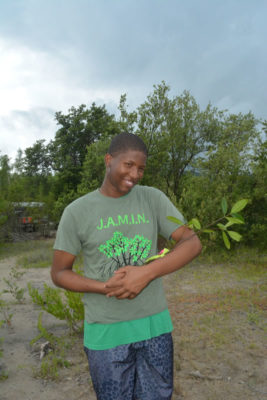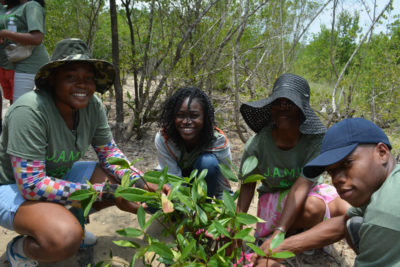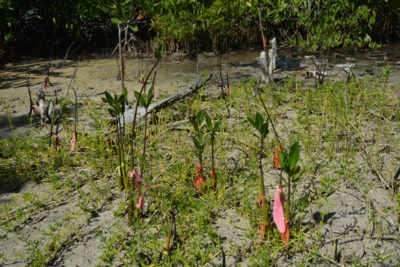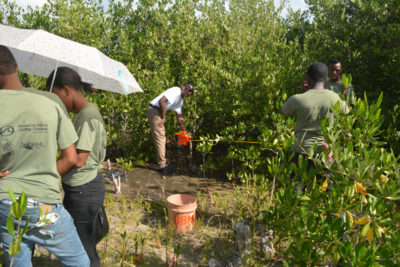Mangrove Education and Restoration Blog
Although it has been raining on and off ever since we arrived in Jamaica, today the weather is absolutely perfect. It’s a good thing too, because as a part of the J.A.M.I.N. year 2 program, the grade 11 Biology students from William Knibb High School are returning to the Falmouth mangrove site to monitor mangroves. The students were not only ecstatic to go on a field trip to monitor mangroves, but many couldn’t wait to see their mangrove propagules (seedlings) that they planted just 6 months ago as part of the year 1 program.

Before planting his mangrove propagule at the restoration site, William Knibb student expresses how he cares for his mangrove propagule. (Photo from year 1 program)

Students at William Knibb High School tag their mangrove propagules with flagging tape in preparation for planting the seedlings. (Photo from year 1 program)
When the students arrived at the mangrove restoration site in Falmouth, they quickly realized that some of their mangrove propagules had grown nice and tall and were thriving in their new environment, while others observed that their mangrove propagules had not survived. The students whose propagules died were very upset by the outcome.

Healthy mangrove seedlings planted at the Falmouth restoration site as part of the J.A.M.I.N. program.
Camilo Trench (our partner at the University of the West Indies Discovery Bay Marine Lab) and I saw this opportunity as a teaching moment. We asked all of the students to gather around. We explained to the students that when mangroves reproduce in a natural setting there are many variables that allow the mangrove propagules to either survive or not.
I asked, “What are the types of factors that exist in an ecosystem?” In unison, the students quickly responded, “abiotic and biotic factors.”
We then asked students which abiotic or biotic factors might cause the mangrove propagules to die. We received a variety of answers. One student said “space,” while another announced “sunlight.” A different student said “pollution” and yet another said “salinity.”
We then recalled that the other day we discussed one of the ways that scientists monitor mangroves is by understanding the success rate of propagule seedlings maturing into adults. I reminded the students that they will be monitoring this in their mangrove plots. We also told the students that from the data that they were collecting in their plot, perhaps they would have evidence as to why some of the propagules in their plot survived while others did not in other plots.
The students shook their heads up and down in understanding. Then I said, “Who is ready to monitor mangroves?” Everyone excited yelled, “Yeah!” The students broke into their groups and started setting up their permanent monitoring plots and collected data. Now the students can begin getting to the “root” of the problem.


Students from William Knibb High School measuring a 5-meter by 5-meter plot in which they will monitor mangroves and various environmental factors such as salinity, pH, and temperature.